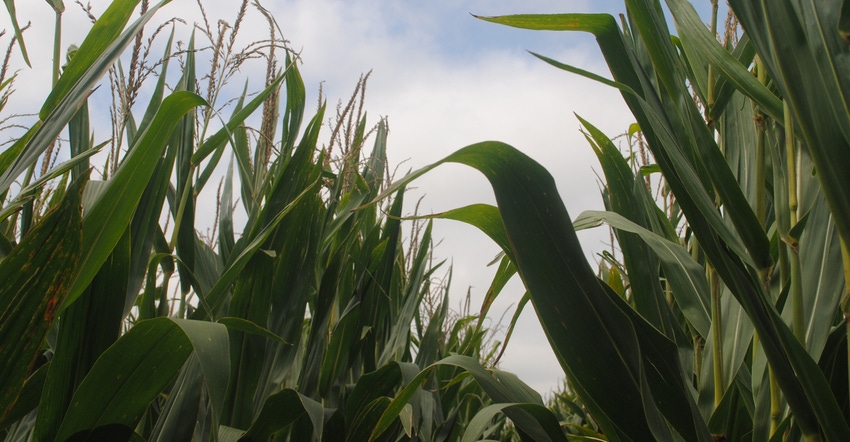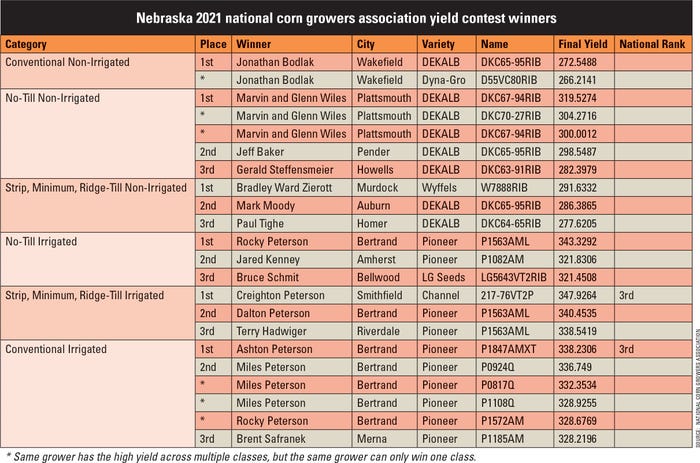
Creighton Peterson majored in agriculture economics and graduated from the University of Nebraska-Lincoln last year, but he’s been farming on his own for three years near Smithfield, Neb.
In 2021, this rookie in the National Corn Growers Association corn yield contest garnered top honors in Nebraska in the strip-, minimum- or ridge-till irrigated category with a yield of 347.9264 bushels per acre, which was also enough to place him third nationally. Although last season was Peterson’s first try in the yield contest, his family has participated for nearly 30 years, placing high in different divisions.
Peterson says that yields in his area in 2021 were about 10% higher than in 2020, although the conditions were hot and dry, with a few timely rains. “We got the right amount of rain at the right time,” he says.
The winning field for Peterson was planted to Channel 217-76VT2P. The family operation normally chooses hybrids that perform well in high-moisture conditions, but on their high-moisture corn and dry corn, they need hybrids that also stand up well, he says.
Although the Petersons usually don’t take leaf samples in their fields, they do sample corn growing in contest fields once per season. “We just started grid soil sampling, and we are getting our fields on a rotation where we do a grid sample from each field every five years,” Peterson says. “We also do quite a bit of fertigation.”
The biggest challenge Peterson sees for 2022 is drought. “We are focused now on getting plants to emerge because this is the driest we’ve had in a long time,” he adds.
Another corn story
Paul Tighe farms mostly flat bottom land around Homer, Neb. Tighe placed third in 2021 in the strip-, minimum- or ridge-till nonirrigated category for Nebraska with a yield of 277.6205 bushels per acre using a DKC64-65RIB Dekalb variety. Tighe says that he has participated in the yield contest over the past five years. His corn ground is mostly minimum till, with some light disking of soybean stubble before corn planting in his corn-soybean crop rotation.
“It’s mostly good ground, sandy loam with just a little gumbo in some places,” Tighe says. “Last season, we were short on rainfall, and yields averaged about 2 bushels per acre less than the year before.”
Tighe bands all of his fertilizer in-furrow about 3 inches from the seed trench at planting time to get it close to the crop root zone, and he pays attention to micronutrient needs as well. He can use Y-drops on his high-clearance applicator for an in-season application. He also sprays the corn with fungicide right after tassel. To keep track of fertility during the growing season, Tighe does leaf sampling to give a snapshot of crop needs.
Tighe plants his soybeans first in April, and last season he planted his 110- to 114-day maturity corn in early May. “We had a couple of good rains,” he says about last season, resulting in decent yields overall, with very little disease or insect pressure.
Looking into this season, Tighe is coming out of winter with soils that are drier than normal, so his main concerns, like Peterson, are fertilizer costs and availability, continued dry weather and marketing the crop under extremely volatile conditions.
Nebraska winners
Nebraska corn yield winners this past year in the NCGA yield contest (see table) include Rocky Peterson, Bertrand, in the no-till irrigated category with a yield of 343.3292 bushels per acre. Jared Kenney, Amherst, took second with 321.8306 bushels, and Bruce Schmit, Bellwood, came in third with 321.4508 bushels.
In the strip-, minimum- or ridge-till irrigated division, Creighton Peterson, Smithfield, got first in Nebraska and third nationally, followed by Dalton Peterson, Bertrand, who posted a yield of 340.4535 bushels per acre for second place in Nebraska, and Terry Hadwiger, Riverdale, who took third with a yield of 338.5419 bushels.
Ashton Peterson, Bertrand, gathered first place in Nebraska and third nationally in the conventional irrigated category with a yield of 338.2306 bushels per acre. Miles Peterson, Bertrand, took second with a yield of 336.749 bushels, and Brent Safranek, Merna, won third with a yield of 328.2196 bushels. Miles and Rocky Peterson actually had higher yields in this division than Safranek, but the rules state that you can only win one class in the contest.

In the nonirrigated categories, under the conventional division, Jonathan Bodlak, Wakefield, took first with a yield of 272.5488 bushels. In the no-till division for nonirrigated, Marvin and Glenn Wiles, Plattsmouth, took first with 319.5274 bushels. They also had the second- and third-highest yields in the category, but Jeff Baker, Pender, took home the second-place prize with 300.0012 bushels per acre, followed by Gerald Steffensmeier, Howells, with 282.3979 bushels.
Finally, in the nonirrigated strip-, minimum- or ridge-till category, Bradley Ward Zierott, Murdock, got first place with a yield of 291.6332 bushels, followed by Mark Moody, Auburn, in second place with 286.3865 bushels, and Paul Tighe, Homer, with 277.6205 bushels for third place.
For more information, visit ncga.com.
About the Author(s)
You May Also Like






